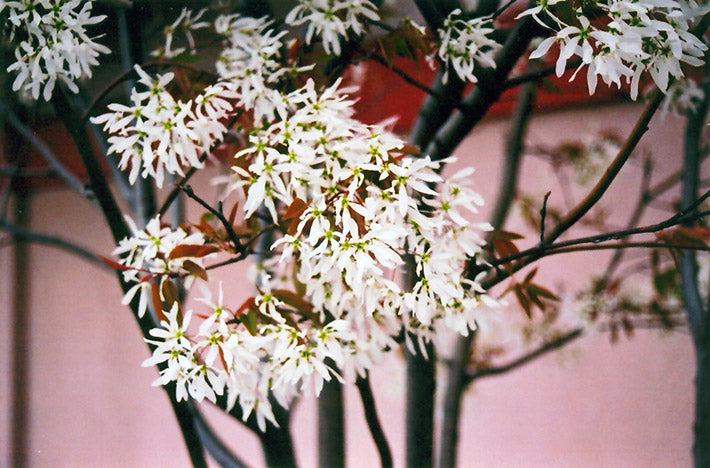Ballerina Serviceberry is blanketed in stunning clusters of white flowers rising above the foliage in early spring before the leaves. It has dark green deciduous foliage which emerges burgundy in spring. The oval leaves turn an outstanding brick red in the fall. It produces purple berries from late spring to early summer. The smooth gray bark adds an interesting dimension to the landscape.
Ballerina Serviceberry is an open multi-stemmed deciduous tree with an upright spreading habit of growth. Its relatively fine texture sets it apart from other landscape plants with less refined foliage.
This is a relatively low maintenance tree, and is best pruned in late winter once the threat of extreme cold has passed. It is a good choice for attracting birds to your yard, but is not particularly attractive to deer who tend to leave it alone in favor of tastier treats. It has no significant negative characteristics.
Ballerina Serviceberry will grow to be about 20 feet tall at maturity, with a spread of 15 feet. It has a low canopy with a typical clearance of 4 feet from the ground, and is suitable for planting under power lines. It grows at a medium rate, and under ideal conditions can be expected to live for 40 years or more.
This tree does best in full sun to partial shade. It prefers to grow in average to moist conditions, and shouldn't be allowed to dry out. It is not particular as to soil type or pH. It is somewhat tolerant of urban pollution. This particular variety is an interspecific hybrid.
Details
Botanical Name
Amelanchier grandiflora 'Ballerina'
Common Name
Ballerina Service Berry
Hardiness Zone
- 4a
Appearance
Max Height
20 feet
Max Spread
15 feet
Plant Form
- Upright Spreading
Foliage Colour
- Dark Green
Fall Colour
- Brick Red
Flower Colour
- White
Edible
Edible Component
Edible Harvest Period
Edible Use
Fruit Colour
- Purple
Growing
Flowering Period
Early Spring
Moisture
Average to Moist
Sunlight
Full Sun to Partial Shade
Maintenance
Low
Deer Resistance
Yes
Get more information about this plant and others with our comprehensive plant finder tool.




